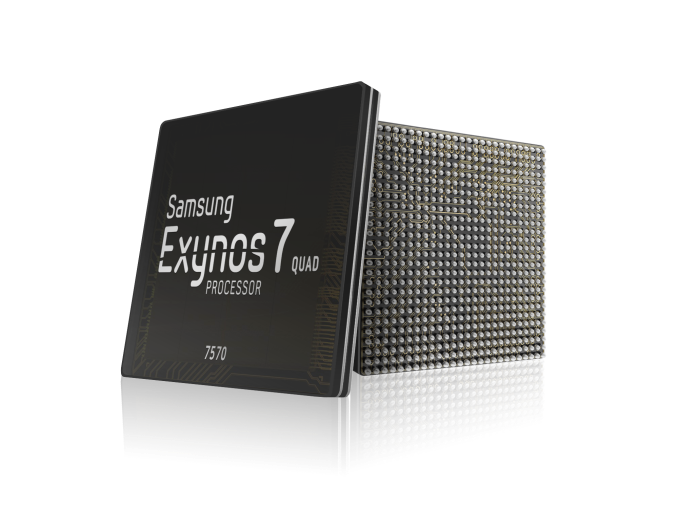Samsung Announces Exynos 7570 14nm Budget SoC
by Andrei Frumusanu on August 30, 2016 6:00 AM EST
Today Samsung LSI launches a new 14nm SoC oriented at the budget and IoT segments. The new Exynos 7570 seems to be a a successor to the Exynos 3470 and Exynos 3475 found in a few of Samsung's budget lineups such as the Galaxy S5 Mini. The chip is a quad-core A53 setup which is said to improve performance by 70% and power efficiency by 30% over its predecessor, although exact clocks weren't publicized. Equally not specified was the GPU, although because of the advertised maximum 1280x800 resolution capabilities of the display pipeline, I wouldn't expect anything more than a very small implementation of a low-end Mali series.
The more interesting aspects of this new SoC is its connectivity features as not only does it feature an integrated UE Category 4 modem with 2x carrier aggregation capabilities, but it also as far as I know for the first time for S.LSI integrates WiFi, Bluetooth, FM and GNSS capabilities, features that have traditionally been left in the charge of dedicated solutions such as Broadcom WiFi SoCs (Which following the acquisition by Avago have exited that business segment).
| SoC | Exynos 7570 | Exynos 7580 | Exynos 7870 |
| CPU | 4x A53 @ ?GHz | 8x A53 @ 1.6GHz | 8x A53 @ 1.6GHz |
| GPU | ? | Mali T720MP3 @ 600MHz |
Mali T830MP2 @ 700MHz |
| Encode/ Decode |
1080p60 H.264 |
||
| Camera/ISP | Dual ISP 21MP / (13+8) |
Dual ISP 16MP / (8+8) |
Dual ISP 16MP / (8+8) |
| Integrated Modem |
Cat. 4 150Mbps DL 2x20MHz C.A. |
Cat. 6 300Mbps DL 2x20MHz C.A. |
Cat. 6 300Mbps DL 2x20MHz C.A. |
| Connectivity | WiFi, BT, FM, GNSS |
N/A | |
| Mfc. Process | 14nm | 28nm HKMG | 14nm |
Earlier this year we were surprised to see Samsung announce a 14nm mid-range product as we weren't expecting the economics of the new FinFET manufacturing processes to work out for anything other than flagships SoCs, but soon after Qualcomm followed suit with their own 14nm mid-range SoC. Today's announcement seems to further dispell the doom & gloom over FinFET manufacturing cost as the Exynos 7570's stictly low-end and IoT orientation makes it the first budget SoC on the new process and something as I see as a positive development as the industry continues to shift to full FinFET lineups.
Source: Samsung Newsroom










17 Comments
View All Comments
Notmyusualid - Tuesday, August 30, 2016 - link
Tell it like it is!Morawka - Tuesday, August 30, 2016 - link
carrier aggregation makes a big difference in burst download speeds, and overall bandwidth. It even helps when the network is congested and your getting slower speeds. I believe it started with Cat6 or better because i had to beg cradlepoint to upgrade their $1500 LTE routers that were still using Cat4.muddling - Friday, September 2, 2016 - link
Exactly. This is fine for inexpensive phones and IoT. You wish your wired broadband at home was that good.zeeBomb - Tuesday, August 30, 2016 - link
I know this question may sound like a broken record...but will we see another deep dive?MrSpadge - Wednesday, August 31, 2016 - link
Of course. But for this SoC? Probably not.. why would anyone be interested in that?Krysto - Thursday, September 1, 2016 - link
Why are we still talking about A53? Shouldn't we be talking about A35 or A32 by now?Meteor2 - Wednesday, September 7, 2016 - link
It takes about two years to go from an ARM design announcement to shipping products. They announce very early.